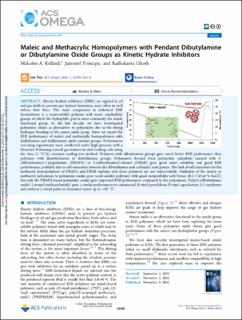| dc.contributor.author | Kelland, Malcolm Andrew | |
| dc.contributor.author | Pomicpic, Janronel Calog | |
| dc.contributor.author | Ghosh, Radhakanta | |
| dc.date.accessioned | 2023-02-17T12:48:07Z | |
| dc.date.available | 2023-02-17T12:48:07Z | |
| dc.date.created | 2022-12-05T14:28:21Z | |
| dc.date.issued | 2022 | |
| dc.identifier.citation | Kelland, M. A., Pomicpic, J., & Ghosh, R. (2022). Maleic and Methacrylic Homopolymers with Pendant Dibutylamine or Dibutylamine Oxide Groups as Kinetic Hydrate Inhibitors. ACS omega, 7(46), 42505-42514. | en_US |
| dc.identifier.issn | 2470-1343 | |
| dc.identifier.uri | https://hdl.handle.net/11250/3051974 | |
| dc.description.abstract | Kinetic hydrate inhibitors (KHIs) are applied in oil and gas fields to prevent gas hydrate formation, most often in cold subsea flow lines. The main component in industrial KHI formulations is a water-soluble polymer with many amphiphilic groups of which the hydrophilic part is most commonly the amide functional group. In the last decade, we have investigated polyamine oxides as alternatives to polyamides due to the strong hydrogen bonding of the amine oxide group. Here, we report the KHI performance of maleic and methacrylic homopolymers with dialkylamine and dialkylamine oxide pendant groups. Performance screening experiments were conducted under high pressure with a Structure II-forming natural gas mixture in steel rocking cells using the slow (1 °C/h) constant cooling test method. Polymers with dibutylamine groups gave much better KHI performance than polymers with dimethylamine or diethylamine groups. Polyamines formed from polymaleic anhydride reacted with 3-(dibutylamino)-1-propylamine (DBAPA) or 2-(dibutylamino)-ethanol (DBAE) gave good water solubility and good KHI performance, probably due to self-ionization between the dibutylamino and carboxylic acid groups. The lack of self-ionization for the methacryl homopolymers of DBAPA and DBAE explains why these polymers are not water-soluble. Oxidation of the maleic or methacryl polyamines to polyamine oxides gave water-soluble polymers with good compatibility with brines (0.5–7.0 wt % NaCl), but only the DBAPA-based polyamine oxides gave improved KHI performance compared to the polyamines. Poly(3-(dibutylamino oxide)-1-propyl methacrylamide) gave a similar performance to commercial N-vinyl pyrrolidone:N-vinyl caprolactam 1:1 copolymer and without a cloud point in deionized water up to +95 °C. | en_US |
| dc.language.iso | eng | en_US |
| dc.publisher | American Chemical Society | en_US |
| dc.rights | Navngivelse 4.0 Internasjonal | * |
| dc.rights.uri | http://creativecommons.org/licenses/by/4.0/deed.no | * |
| dc.title | Maleic and Methacrylic Homopolymers with Pendant Dibutylamine or Dibutylamine Oxide Groups as Kinetic Hydrate Inhibitors | en_US |
| dc.title.alternative | Maleic and Methacrylic Homopolymers with Pendant Dibutylamine or Dibutylamine Oxide Groups as Kinetic Hydrate Inhibitors | en_US |
| dc.type | Peer reviewed | en_US |
| dc.type | Journal article | en_US |
| dc.description.version | publishedVersion | en_US |
| dc.rights.holder | The authors | en_US |
| dc.subject.nsi | VDP::Matematikk og Naturvitenskap: 400 | en_US |
| dc.source.pagenumber | 0 | en_US |
| dc.source.journal | ACS Omega | en_US |
| dc.identifier.doi | 10.1021/acsomega.2c05713 | |
| dc.identifier.cristin | 2088863 | |
| cristin.ispublished | true | |
| cristin.fulltext | original | |
| cristin.qualitycode | 1 | |

